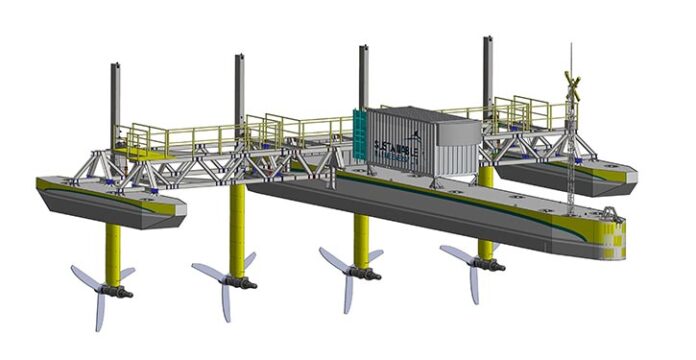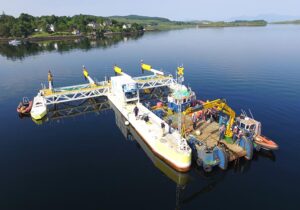
Sustainable Marine Energy (SME), based in Edinbourgh /Scotland, is preparing to ship its PLAT-I (the “I” indicates that the unit is designed for inshore energy) surface floating tidal energy power platform, with four Schottel Hydro SIT 250 turbines, from its current testing location in Connel on the west coast of Scotland to Nova Scotia in Canada for the next round of tests.
The 280kW PLAT-I is 32 meters long, with a beam of 27 meters. The platform’s modular design can be broken down for shipping and assembled close to site, the shallow draft configuration also permits launch and tow out with limited port infrastructure. The platform is integrated with mooring turret which enables alignment with flow in any direction, while turbines have been configured for maximum power extraction in shallow water channels. Swing up turbine deployment modules allow maintenance access at the surface.
The first tests have proven the installation, operation and performance of the platform; now, the second testing programme will assess its performance in Canada’s harsher climate, conducting environmental monitoring and assessing interaction with marine life. Black Rock Tidal Power Inc has applied Nova Scotia’s Department of Energy for permission to install the platform at Grand Passage for a minimum three-month trial period.
Schottel Hydro’s sales director and head of Hydrodynamics Dr Ralf Starzmann, commented: “Connel has provided a fantastic testing facility for us with challenging tides and turbulence allowing us to test every foreseeable turbine mode. We are very happy with the data coming from the turbines, performing exactly to specification. Necessary turbine interventions during the testing had been carried out it in situ, with only a small vessel required, this just wouldn’t have been possible without the flexibility and modularity of the PLAT-I platform.”
The floating tidal power energy station, hosting four SCHOTTEL HYDRO SIT 250 turbines, has successfully completed the first phase of its testing programme at Connel, on the West coast of Scotland. The Company is now preparing to ship the platform to Nova Scotia and install it for a second phase of testing. Having proven the installation, operation and performance aspects of the platform, this second phase of testing will concentrate on proving performance in the harsher climate of Canada while also conducting environmental monitoring, with the aim of assessing interactions of marine life with the platform. Black Rock Tidal Power Inc has applied to the Nova Scotia Department of Energy for permission to install the platform at Grand Passage for a minimum trial period of 3 months and, as part of that process, is currently engaging with stakeholders in the local area.
Jason Hayman, Managing Director of SME commented “PLAT-I is graduating from Scotland to Canada, which is an important start to the export story for the Scottish marine energy industry. It also represents a change of gear for Sustainable Marine Energy, we started as an R&D company and are rapidly changing into a project delivery company based in Scotland.” He continued “This has demonstrated by what our team has achieved in little more than 12 months. We have consented a new site, designed and built a new platform and have successfully run our complete testing programme in record time. I am grateful to the local community in Connel who hosted the first PLAT-I test, and very excited about what the next 12 months holds for us in Nova Scotia.”

The PLAT-I platform was designed with support from Innovate UK and DFID under the Energy Catalyst programme, with the build and testing receiving funding from Scottish Enterprise under the WATERS3 programme. The testing programme has successfully validated the platform and power generation technologies, with multiple platform motions and loads being measured. All systems performed as expected allowing the key advantages of the PLAT-I system to be proven. From the outset low cost assembly and marine operations it has been a key design driver with both of these being demonstrated in the Connel testing programme. The modular nature of the platform, whilst making assembly on land easy with small cranes, has also allowed a number of components to be changed during the testing programme. Uniquely to the PLAT-I platform it has been possible to change out blades and work on the SCHOTTEL SIT generators in situ, with only small vessels required.
In addition the testing period has allowed collaboration with a number of research projects including SURFTEC, MET-Certified and Tidal Turbine Testing Phase 3 (TTT3). All have deployed instrumentation on or around the platform, monitoring a number parameters and their research will be publicly disseminated when complete.
SME is now teaming up with the Canadian company Black Rock Tidal Power Inc (BRTP) for this important follow on project, which will evaluate the environmental impact and commercial potential of the PLAT-I technology. BRTP is working closely with all of the relevant regulatory bodies in Nova Scotia and Canada to ensure that the Grand Passage deployment will increase scientific understanding of marine animal behaviour near the platform and provide a test bed for environmental monitoring systems. The results of the second phase of testing will provide regulators with more information to evaluate future tidal energy projects in the Bay of Fundy.
Jason Hayman, Managing Director of SME said “Canada is an obvious choice for the next stage of PLAT-I and SME’s development because of the abundant resource in and around the Bay of Fundy. The area has fantastic natural resource, all driven by the largest tidal range in the world at up to 14m. But more than that, Canada, and Nova Scotia in particular is the key to SME’s commercial strategy due to the revenue support available for the generation of clean energy from the tides. The Feed-in Tariff will allow us to reduce cost through cumulative deployment of tidal energy technology and be in a position to service markets globally including South East Asia.”
The PLAT-I platform is currently being prepared for shipping to Canada. The platform was towed away from the Connel Bridge site on the 7th of June by the 15m Meercat workboat VENETIA, a confirmation of how the PLAT-I platform is lowering the bar in terms of the size of marine assets required to perform operations.



